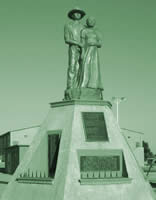The Agricultural Colony �Irrigación� had his first origins in 1939. In this year the delegation of the Revolutionary Veterans Union in the �Angostura� Dam had the initiative to form an Agricultural Colony based on the offers and acts of the President of Mexico, C. Gral. Lazaro Cardenas del Rio.
Because of the threat, in that year, of the readjustment of the workers in the dam, the union of Veterans invited the Local Section #2 of the National Union of Workers of the Irrigation to unite efforts and together harvest the land watered by the reservoir that in common had constructed.
That's how formerly Revolution Soldiers and the people of the National Union of Workers of the irrigation came out with the reality to have a new center of production.
The Agricultural Colony �Irrigación� was settled in 1942 with bases and statutes as a voluntary association, it had 151 partners (139 originally from the Angostura dam and 12 from the �Alvaro Obregon� dam) they managed to acquire 20=00=00 hectares each partner in the region of the Yaqui valley.
The constant and tenacious goal of this Colony, was the elevation of the standards of life of the partners and the society, being also its ideal objective the creation of better conditions of life. And with the course of the years make bloom the human qualities in the arts and science field.
Once the Colony was constructed with the bases and statutes that were going to prevail, the settlers organized and formed the first 4 societies: �La Angostura�, �La Hércules�, �Esperanza� y �Estrella�. And 3 year later: �La Valsequillo�.
 5 years later the Magnus Colony was settled with 6 societies: �Buenos Aires�, �Buena Vista�, �Norte�, �20 Noviembre�, �Los Niños Heroes�, and �La Sociedad Magnus�. All with the main purpose of being able to obtain credit supports by the National Bank of Agricultural Credit, to start creating roads, digging, ground leveling, everything done using tips, shovels, saws and axes, helped by the animals work. They were intense and exhausting days of work, dealing with the weather and the wild fauna.
5 years later the Magnus Colony was settled with 6 societies: �Buenos Aires�, �Buena Vista�, �Norte�, �20 Noviembre�, �Los Niños Heroes�, and �La Sociedad Magnus�. All with the main purpose of being able to obtain credit supports by the National Bank of Agricultural Credit, to start creating roads, digging, ground leveling, everything done using tips, shovels, saws and axes, helped by the animals work. They were intense and exhausting days of work, dealing with the weather and the wild fauna.
In 1943 the settlers bought to the �Compañia Irrigadora del Yaqui� (formerly Richardson Constructing) a lot of 192=50 hectares to settle the town called �Colonia Irrigación� constituted as a delegation of the Bacobampo Police Station, Municipality of Etchojoa.
The fishing towns emerged at the same time of the Colonies by 1938, with the expedition of the Law of Cooperative Societies �Paredon Colorado� and �Paredoncito� they were founded by fishermen who each season camped in the margins of the �Tobari� Bay. The Fishing Cooperative Society �Paredon Colorado� was settled in 1939, and later, by division of it, the one called �Tobari�.
In 1946 the Agricultural Colony Ricardo Flores Magon was created, in the denominated estate Magnus, the pioneers settled down in the old farm �Agua Blanca�. In September 20 of 1947 the Sonora State Congress approved the law proposed by the Etchojoa city hall, converting the Colony �Irrigación� into a Police Station �Colonia Irrigación�.
In 1950, the community of the �Colonia Irrigación�, formally asked the State Government for their town to became municipality because they considered it had already reached an enough development degree for that. In 1951, the Agricultural Colony Jecopaco was settled down, and shortly after that it became the town of the same name. The founders arrived at almost the same time as the Colony �Irrigación� ones did. In July 27 of 1957 honoring the �Reforma� national hero, and because of a popular consult, the police station changed its name to �Villa Juarez�.
In 1988 and because of the land expropriation in 1976 in the Yaqui and Mayo valleys, the town enlarged 83=50=00 hectares in the 2220 block. In that place it was established an urban zone in which 1,263 families settled down. All this people is grouped in the South Sonora Rural Production Societies Union (USPRUSS).
 After a long series of managements of the Patronage Pro-Municipality and other sectors of Villa Juárez since the 50s, it is created through Law #253, published in the government reporter with date December 26 of 1996 the municipality of Benito Juárez. Being constituted by the present delegations of Paredón Colorado, Paredoncito, Batevito, Col. Jecopaco, Agua Blanca, Aceitunitas, Zona Urbana Ejidal Ley Echeverria and the localities that in that moment belonged to them.
After a long series of managements of the Patronage Pro-Municipality and other sectors of Villa Juárez since the 50s, it is created through Law #253, published in the government reporter with date December 26 of 1996 the municipality of Benito Juárez. Being constituted by the present delegations of Paredón Colorado, Paredoncito, Batevito, Col. Jecopaco, Agua Blanca, Aceitunitas, Zona Urbana Ejidal Ley Echeverria and the localities that in that moment belonged to them.
In the different festivities, it's very typical to find the deer suits, the �fariseo� and �matachin� clothes as well as �pascola� suits. The �mayo� Indians that inhabit our municipality make woven bed rolls of reed, �fariseo� masks, willow and poplar based chairs and tables, �guaris�, reed baskets, �pascola� masks, �matachines� crowns, �huaraches� and bags of ixtle. There are 2 monuments considered as sculptures: The Monument of Benito Juárez and the Monument of the Settlers that formed this town.
Up

